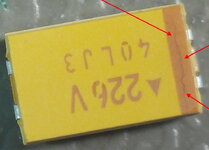Vasilevski
Junior Member level 2
Hello all.
Straight to the point. I work for an electronics company. We deal with a manufacture of power supplies 1-4kW. We have a tantalum capacitors malfunction problem from time to time. We usually use AVX or Kemet tantalum capacitors. An annual consumption of the capacitors usually is around 60 000 psc. An annual amount of the malfunction capacitors I would say is in a range of 0.05-0.15% of the annual consumption. The supply chain includes only official dealers ala Digikey or similar, so I'm sure that counterfeit parts are not the reason of the problem. I haven't been able to find any correlation between a batch number of the capacitors or a location on PCBs and the tantalum capacitors malfunction. Sometimes we do not see any problems with the capacitors for a month and than have 5-20 cases of the malfunction in a few days. As to the circumstances of the malfunction, I can say, that 90-95% of the tantalum malfunction are burnouts of the capacitors during the first time power supply appliance. Possibly, the most plausible reasons of the malfunctions are manufacturing defects or some issues with the reflow temperature profile during a soldering process (though, it was chosen in accordance with manufacturers recommendations). So here my questions:
1. Have you ever faced with a similar problem? It would be great if you could share your experience.
2. How would you assess "normal" amount of manufacturing defects for tantalum capacitors?
3. Do you have an experience of eliminating the reasons of electronics parts damage during a solder reflow process? What would you recommend?
I would appreciate any ideas or thoughts! Thanks in advance!
Straight to the point. I work for an electronics company. We deal with a manufacture of power supplies 1-4kW. We have a tantalum capacitors malfunction problem from time to time. We usually use AVX or Kemet tantalum capacitors. An annual consumption of the capacitors usually is around 60 000 psc. An annual amount of the malfunction capacitors I would say is in a range of 0.05-0.15% of the annual consumption. The supply chain includes only official dealers ala Digikey or similar, so I'm sure that counterfeit parts are not the reason of the problem. I haven't been able to find any correlation between a batch number of the capacitors or a location on PCBs and the tantalum capacitors malfunction. Sometimes we do not see any problems with the capacitors for a month and than have 5-20 cases of the malfunction in a few days. As to the circumstances of the malfunction, I can say, that 90-95% of the tantalum malfunction are burnouts of the capacitors during the first time power supply appliance. Possibly, the most plausible reasons of the malfunctions are manufacturing defects or some issues with the reflow temperature profile during a soldering process (though, it was chosen in accordance with manufacturers recommendations). So here my questions:
1. Have you ever faced with a similar problem? It would be great if you could share your experience.
2. How would you assess "normal" amount of manufacturing defects for tantalum capacitors?
3. Do you have an experience of eliminating the reasons of electronics parts damage during a solder reflow process? What would you recommend?
I would appreciate any ideas or thoughts! Thanks in advance!
